
Introduction
The 27" monitor market has become quite crowded
over the last few years, but there's still a real interest in finding a good
all-round display in this sector. BenQ have recently introduced their new
GW2765HT screen which is based around a 2560 x 1440 resolution QHD panel. As
with most of the 27" 1440p models, the panel is an IPS-type, actually using an
AU Optronics AHVA (Advanced Hyper Viewing Angle) module which is their
equivalent to the more well-known LG.Display IPS brand. The screen is designed
for home entertainment and office work according to the BenQ website, with a
focus on user comfort and eye health which has become a hallmark for BenQ
screens in recent times. When the screen was first announced there was a focus
in their marketing content on the screens gaming performance as well, although
this seems to have been changed on the product webpage now. We are keen to see
what this new screen can deliver and whether it offers a good all-round
performance in this size range.
If you appreciate the review
and enjoy reading and like our work, we would welcome a
donation
to the site to help us continue to make quality and detailed reviews for you.
|
Check Pricing and Buy - Direct Links
|
|
Amazon USA |
Amazon
UK | Amazon GER |
Amazon CAN
|
|
TFTCentral is a participant
in the Amazon Services LLC Associates Programme, an affiliate
advertising programme designed to provide a means for sites to earn
advertising fees by advertising and linking to Amazon.com, Amazon.co.uk,
Amazon.de, Amazon.ca and other Amazon stores worldwide. We also
participate in a similar scheme for Overclockers.co.uk. |

Specifications and Features
The following table gives detailed information
about the specs of the screen:
|
Monitor
Specifications |
|
Size |
27"WS |
Panel Coating |
Light semi-glossy AG coating |
|
Aspect Ratio |
16:9 |
Interfaces |
D-sub, DL-DVI, HDMI 1.4, DisplayPort |
|
Resolution |
2560 x 1440 |
|
Pixel Pitch |
0.2331 mm |
Design
colour |
Glossy black bezel, matte black base to stand |
|
Response Time |
4ms G2G
12ms ISO |
Ergonomics |
Tilt, height, swivel and rotate |
|
Static Contrast Ratio |
1000:1 |
|
Dynamic Contrast Ratio |
20 million:1 |
VESA Compatible |
Yes
100mm |
|
Brightness |
350 cd/m2 |
Accessories |
Power cable, VGA, HDMI, DisplayPort |
|
Viewing Angles |
178/178 |
|
Panel Technology |
AU Optronics AHVA (IPS-type) |
Weight |
Net
weight: 6.9Kg |
|
Backlight Technology |
W-LED |
Physical Dimensions |
(WxHxD) with stand max height
641 x 555 x 244 mm |
|
Colour Depth |
1.07b (8-bit + FRC) |
|
Refresh Rate |
60Hz |
Special
Features |
Audio input, headphone output, 2x 1W stereo speakers, Low Blue Light Mode |
|
Colour Gamut |
Standard gamut 100% sRGB, 80% NTSC, 79.1%
Adobe RGB |
The GW2765HT offers a good range of connectivity options. There are
D-sub, Dual-link DVI, HDMI and DisplayPort interfaces provided for video
connections. Cables are provided in the box for only VGA, HDMI and DisplayPort,
but not for DVI for some reason.
The screen has an internal power supply so there
is only the need for a kettle lead power cable (provided). There are several
additional features as well for this screen. These include 2x 1W stereo
speakers, an audio input, headphone output and BenQ's Low Blue Light Mode
technology. There are unfortunately no USB ports provided on this model which is
a bit of a shame as we feel they can be very useful and are pretty standard on
most monitors now.
Below is a summary of the features and connections
of the screen:
|
Feature |
Yes / No |
Feature |
Yes / No |
|
Tilt adjust |
 |
DVI |
 |
|
Height adjust |
 |
HDMI |
 |
|
Swivel adjust |
 |
D-sub |
 |
|
Rotate adjust |
 |
DisplayPort |
 |
|
VESA compliant |
 |
Component |
 |
|
USB 2.0 Ports |
 |
Composite |
 |
|
USB 3.0 Ports |
 |
Audio connection |
 |
|
Card Reader |
 |
HDCP Support |
 |
|
Ambient Light Sensor |
 |
MHL Support |
 |
|
Human Motion Sensor |
 |
Integrated Speakers |
 |
|
Touch Screen |
 |
PiP / PbP |
 |
|
Hardware calibration |
 |
Blur Reduction Mode |
 |
|
Uniformity correction |
 |
G-Sync |
 |

Design and Ergonomics
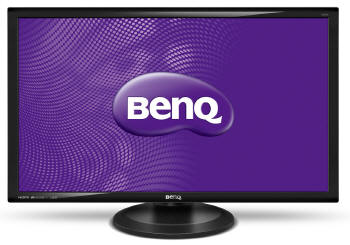
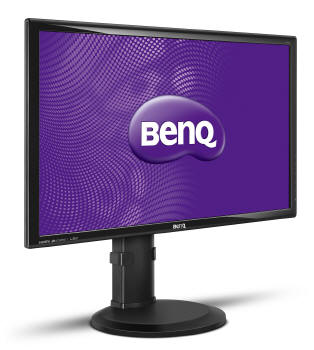
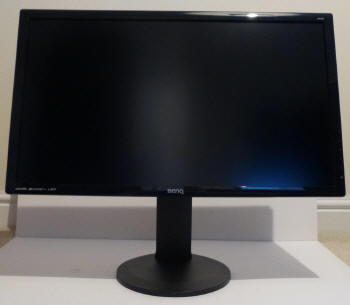
Above: front view of the screen. Click for larger version
The GW2765HT comes in an all-black design.
Glossy black plastics are used for the bezel around the panel. This
measures ~20mm around all sides so is reasonably thin. Not ultra-thin like
a lot of the recent screens seem to be offering. There are logos on the
bottom left hand edge for HDMI, Senseye and LED. In the middle of the
lower bezel is a BenQ logo as well, and in the top right hand corner a
small "GW2765" model label. Along the lower right hand edge are 5 small
grey circles marking the location of the OSD control buttons, and a power
logo also. The actual buttons are located on the back right hand edge of
the screen (as viewed from the front), so these circles just mark where
the buttons are for easier use.
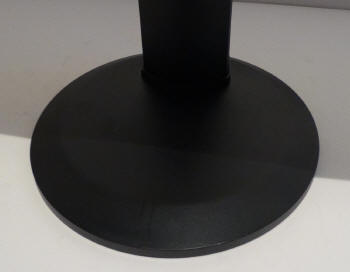
Above: view of the base of the stand. Click for larger version
The stand and base are a matte black
plastic. The base is circular and provides a sturdy support for the pretty
larger screen.
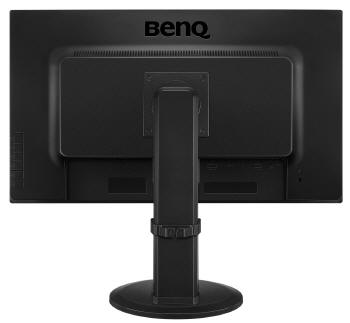
Above: rear view of the screen, click for larger version
The back of the screen is finished in a
matte black plastic. There is a large BenQ logo etched in to the top
portion and the back section is squared off as shown above. On the back of
the stand is a detachable cable tidy clip which is useful.
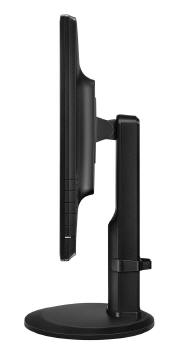
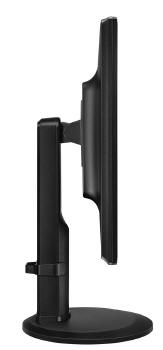
Above: side views of the screen, click for larger versions
From the side the screen offers a pretty
thin profile thanks to the LED backlight. The stand is a bit more chunky
as you can see, but provides a sturdy and well adjustable base for the
screen.
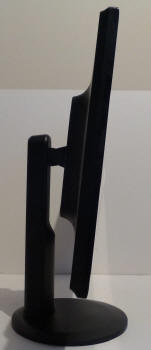
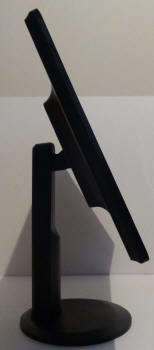
Above: full tilt range shown, click for larger versions
The tilt adjustment is smooth and easy to
use, offering a wide range of adjustment angles for your comfort.
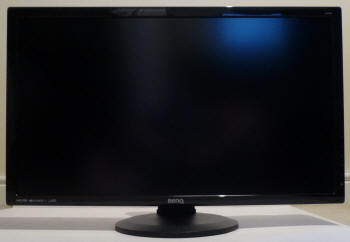
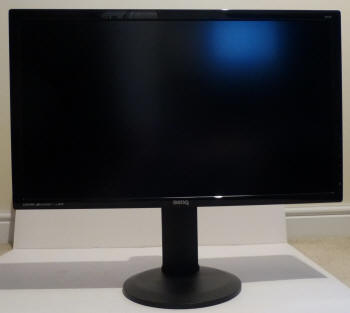
Above: full height adjustment range shown. Click for larger versions
The height adjustment offers a total 130mm
adjustment range. It is smooth and very easy to move. At the lowest
height, the bottom edge of the screen is ~50mm from the top of the desk,
and at the maximum height it is ~180mm.
Side to side swivel is a bit stiff to use.
The bottom of the base has a rotating section to it which helps you move
the screen side to side, but it isn't the easiest to use. Rotation into
portrait mode is available but also quite stiff to operate.
A summary of the screens ergonomic adjustments
is shown below:
|
Function |
Range |
Smoothness |
Ease of Use |
|
Tilt |
Yes |
Smooth |
Easy |
|
Height |
130mm |
Smooth |
Very easy |
|
Swivel |
Yes |
Smooth |
Stiff |
|
Rotate |
Yes |
Quite Smooth |
Quite stiff |
|
Overall |
Good range of adjustments but
movements are a little stiffer than hoped, especially swivel |
The materials were of a good standard and the
build quality felt good as well. There was no audible noise from the screen,
even when conducting specific tests which can often identify buzzing issues.
The whole screen remained very cool even during prolonged use as well which
was pleasing.

Above: input connections shown. Click for larger version
The back of the screen has the various
connection options available. These are DVI, HDMI, DisplayPort, D-sub VGA,
audio input and audio output.

OSD Menu

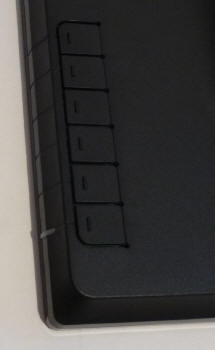
Above: OSD control buttons front view (left) and rear view (right)
The OSD menu is controlled through a series of 5
pressable buttons located on the rear right hand edge of the screen. There is
also a pressable power on/off button. You have to feel behind the screen to use
these buttons but there is a little ridge on each so you know where you are, and
on the front of the bezel is a small grey circle so you know which button you
are pressing. When pressing any of the buttons a guide appears on the screen (as
shown in the Low Blue Light Mode photo example below) telling you what each of
the buttons will then do, whether that's scroll up or down, select, exit etc.
The power LED is located on the right hand side of the screen and you can't
really see this during use of the screen. It glows green during normal operation
and amber in standby.
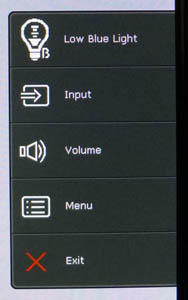
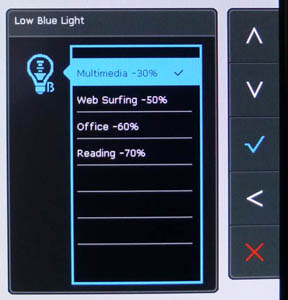
Pressing any of the buttons first of all pops up
the quick launch menu as shown above (left). By default there are the options
shown, but you can actually customise these in the main OSD to something you
use more regularly if you want. You can launch into these quick access menus
by pressing the corresponding button. Above (right) is the Low Blue Light Mode
menu with 4 options available with different levels of blue light reduction.
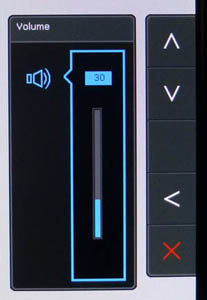
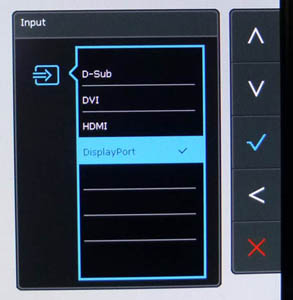
The quick access menus for volume control and input selection are shown above
as well.
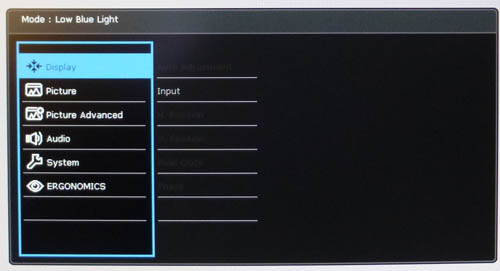
The main OSD menu is split in to 6 sections shown down the left hand side. As
you scroll down these sections, the options available in each are shown in the
right. In these photos, quite a few of the options listed are a very light
grey, which hasn't been picked out very well by the camera. As a result there
are quite a lot of "hidden" options in each section but we will try and
explain anything useful in the text here.
The first 'Display' menu allows you to choose
the input. If you are using D-sub VGA then a few other options related to the
signal and image are shown as you would normally see from a VGA input.
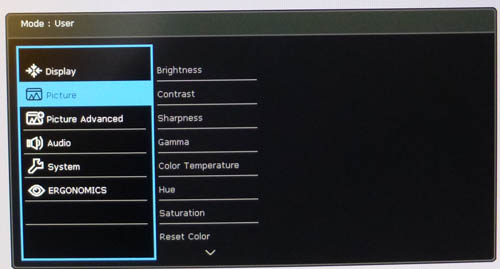
The 'Picture' menu contains a lot of options. There are settings here for
things like brightness and contrast, as well as the range of preset
gamma and color
temperature modes. If you scroll down past the bottom of the options shown
there is also the
AMA (Advanced
Motion Accelerator = response time) control.
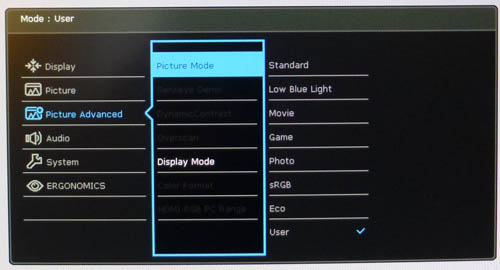
The 'Picture Advanced' menu has a few more advanced features. Shown here is
the 'picture mode' option with a range of preset modes available to try.
Greyed out here are options for Senseye Demo, Dynamic contrast, overscan,
colour format and HDMI RGB PC range which appear depending on the connection
used or mode you are in.
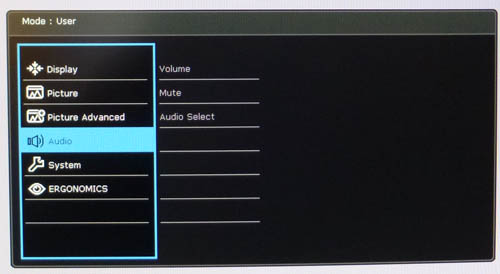
The 'Audio' menu allows you to control the speakers or audio output if you're
sending sound to the screen over HDMI or via the audio input.
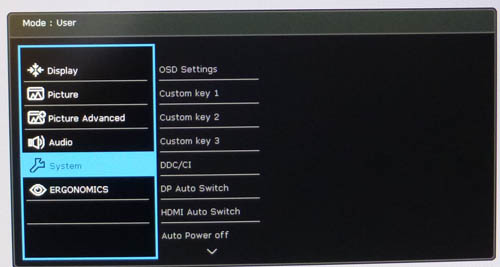
The 'System' menu allows you to control various aspects of the OSD menu
itself, including changing the quick access options which is useful.
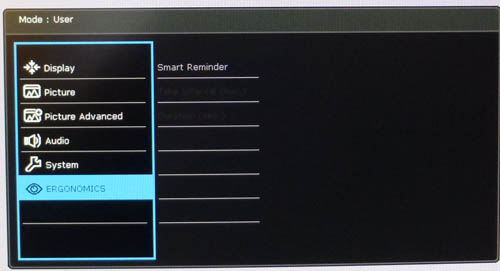
Finally the 'Ergonomics' section has a 'smart
reminder' feature where you can set the time interval as well.
All in all we felt the OSD menu offered a good
range of options. There were plenty of preset modes, and having control over
things like the overdrive impulse are always welcome. The navigation was
sometimes a little tricky because of the placement of the buttons, and it was
not always immediately obvious which button you were lined up with. Once you
had that figured out, the movement around the menus was quick and simple. The
menu doesn't remember where you last were either, so if you exit the menu, you
have to start all over again from the beginning when you next go in to it.

Power Consumption
In terms of power consumption the manufacturer
lists an "on mode" consumption of 55W and less than 0.5W in standby. We carried out our normal tests to
establish its power consumption ourselves.
|
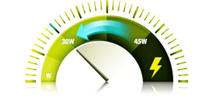 |
|
State and Brightness
Setting |
Manufacturer Spec (W) |
Measured Power Usage
(W) |
|
Default (100%) |
55.0 |
44.6 |
|
Calibrated (18%) |
- |
21.5 |
|
Maximum Brightness (100%) |
- |
44.6 |
|
Minimum Brightness (0%) |
- |
17.0 |
|
Standby |
<0.5 |
0.6 |
|
We tested this ourselves and found that out of the
box the screen used 44.6W at the default 100% brightness setting. Once calibrated the screen reached
21.5W consumption, and in standby it
used only 0.6W. We have plotted these results below compared with other screens
we have tested. The consumption is comparable actually to the other W-LED
backlit displays we have tested, with GB-r-LED backlit
displays (Dell U2713H, ViewSonic VP2772 as examples) using a bit more than most W-LED
backlights.


Panel and Backlighting
|
Panel Manufacturer |
AU Optronics |
Colour Palette |
1.07 billion |
|
Panel Technology |
AHVA (IPS-type) |
Colour Depth |
8-bit + FRC |
|
Panel Module |
M270DAN01.0 |
Colour space |
Standard gamut |
|
Backlighting Type |
W-LED |
Colour space coverage (%) |
80.0% NTSC, 100.0% sRGB, 79.1% Adobe RGB |
Panel Part and Colour Depth
The BenQ GW2765HT utilises an
AU Optronics M270DAN01.0 AHVA (Advanced Hyper Viewing Angle) panel. This is
an IPS-type technology, not to be confused with AUO's AMVA (Vertical Alignment /
VA type) technology.
The panel is capable of producing 1.07 billion colours through an 8-bit colour
depth and additional Frame Rate Control (FRC) stage.
This "10-bit" support is available when using the DisplayPort interface only
according to the spec sheet. Keep in mind whether this is practically useable
and whether you're ever going to truly use that colour depth. You need to
have a full 10-bit end to end workflow to take advantage of it which is still
quite expensive to achieve and rare in the market, certainly for your average
user. This includes relevant applications and graphics cards as well, so to many
people this 10-bit support might be irrelevant.
The panel is confirmed when accessing the factory
OSD menu as shown below:
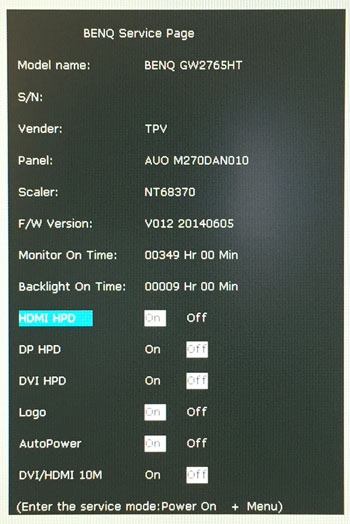
Screen
Coating
The
screen coating on the GW2765HT is a light, semi-glossy anti-glare (AG) offering. Thankfully it
isn't a heavily grainy coating like some old IPS panels feature. It retains its anti-glare properties to
avoid too many unwanted reflections of a full glossy coating, but does not
produce an too grainy or dirty an image that some thicker AG coatings can. There
were no cross-hatching patterns visible on the coating.
Backlight Type and Colour Gamut
The screen uses a White-LED (W-LED) backlight unit
which has become very popular in today's market. This helps reduce power
consumption compared with older CCFL backlight units and brings about some
environmental benefits as well. The W-LED unit offers a standard colour gamut
which is equal to the sRGB colour space (100% sRGB quoted).
Anyone wanting to work with wider colour spaces would need to consider wide
gamut CCFL screens or the newer range of GB-r-LED type displays available
now. If
you want to read more about colour spaces and gamut then please have a read of
our
detailed article.
Backlight
Dimming and Flicker
We tested the screen to establish the methods used
to control backlight dimming. Our in depth article talks in more details about a
common method used for this which is called
Pulse Width Modulation (PWM). This in itself gives cause for concern to some
users who have experienced eye strain, headaches and other symptoms as a result
of the flickering backlight caused by this technology. We use a photosensor +
oscilloscope system to measure backlight dimming control
with a high level of accuracy and ease. These tests allow us to establish
1) Whether PWM is being used to control the
backlight
2) The frequency and other characteristics at which this operates, if it is used
3) Whether a flicker may be introduced or potentially noticeable at certain
settings
If PWM is used for backlight dimming, the higher
the frequency, the less likely you are to see artefacts and flicker. The duty
cycle (the time for which the backlight is on) is also important and the shorter
the duty cycle, the more potential there is that you may see flicker. The other
factor which can influence flicker is the amplitude of the PWM, measuring the
difference in brightness output between the 'on' and 'off' states. Please
remember that not every user would notice a flicker from a backlight using PWM,
but it is something to be wary of. It is also a hard thing to quantify as it is
very subjective when talking about whether a user may or may not experience the
side effects.
100% 50%
0%
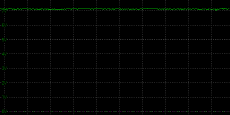
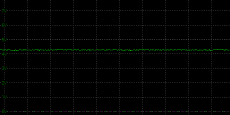
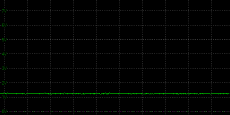
Above scale = 1
horizontal grid = 5ms
At all brightness settings a constant voltage is
applied to the backlight and there is no sign of Pulse Width Modulation (PWM)
being used. Instead, a direct current (DC) method is used and the screen is
certified and confirmed as being flicker free. Good news.
|
Pulse Width
Modulation Used |
No |
|
Cycling
Frequency |
n/a |
|
Possible
Flicker at |
|
|
100% Brightness |
No |
|
50% Brightness |
No |
|
0% Brightness |
No |
For an up to date list of all flicker-free (PWM free) monitors please see our
Flicker Free Monitor Database.

Contrast
Stability and Brightness
We wanted to see how much variance there was in
the screens contrast as we adjusted the monitor setting for brightness.
In theory, brightness and contrast are two independent parameters, and good
contrast is a requirement regardless of the brightness adjustment.
Unfortunately, such is not always the case in practice. We recorded the
screens luminance and black depth at various OSD brightness settings, and
calculated the contrast ratio from there. Graphics card settings were left at
default with no ICC profile or calibration active. Tests were made using an
X-rite i1 Display Pro colorimeter. It should be noted that we used the
BasICColor calibration software here to record these, and so luminance at
default settings may vary a little from the LaCie Blue Eye Pro report.
|
OSD
Brightness |
Luminance
(cd/m2) |
Black
Point (cd/m2) |
Contrast
Ratio
( x:1) |
|
100 |
367.24 |
0.37 |
993 |
|
90 |
340.27 |
0.34 |
1001 |
|
80 |
311.80 |
0.31 |
1006 |
|
70 |
282.66 |
0.28 |
1010 |
|
60 |
252.27 |
0.25 |
1009 |
|
50 |
221.00 |
0.22 |
1005 |
|
40 |
190.90 |
0.19 |
1005 |
|
30 |
161.15 |
0.16 |
1007 |
|
20 |
128.86 |
0.13 |
991 |
|
10 |
95.87 |
0.10 |
959 |
|
0 |
62.15 |
0.06 |
1036 |
|
Total Luminance Adjustment Range
(cd/m2) |
305.09 |
Brightness OSD setting controls backlight? |
 |
|
Total Black Point
Adjustment Range (cd/m2) |
0.31 |
|
Average Static Contrast Ratio |
1002:1 |
PWM Free? |
 |
|
Recommended OSD setting
for 120 cd/m2 |
17 |
The brightness control gave us a very good range
of adjustment. At the top end the maximum luminance reached 367
cd/m2 which was
high, and even a bit higher than the specified maximum brightness of 350 cd/m2
from the manufacturer. There was a decent 305 cd/m2 adjustment range
in total, and so at the minimum setting you could reach down to a low luminance
of 62 cd/m2. This should be adequate for those wanting to work in
darkened room conditions with low ambient light. A setting of 17 in the OSD menu should return you a
luminance of around 120 cd/m2 at default settings.
It should be noted that the
brightness regulation is controlled without the need for
Pulse Width Modulation, using a Direct Current (DC) method for all brightness settings
between 100 and 0% and so the screen is flicker free.
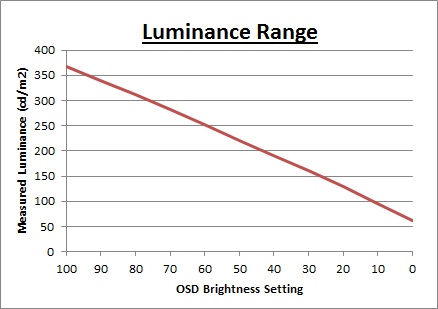
We have plotted the
luminance trend on the graph above. The screen behaves as it should in this
regard, with a reduction in the luminance output of the screen controlled by the
reduction in the OSD brightness setting. This is a linear relationship.
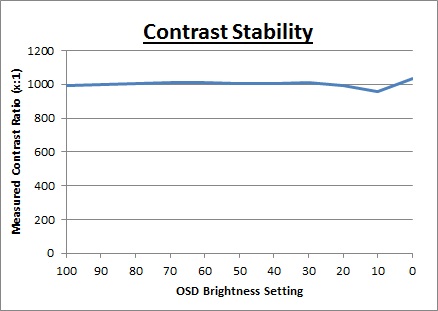
The average contrast ratio of
the screen was very good for an IPS panel with an average of 1002:1. This was
very stable across the brightness adjustment range as shown above although at
the lowest brightness settings it did fluctuate a little.

Testing
Methodology
An
important thing to consider for most users is how a screen will perform out of
the box and with some basic manual adjustments. Since most users won't have
access to hardware colorimeter tools, it is important to understand how the
screen is going to perform in terms of colour accuracy for the average user.
We restored our graphics card to default settings and disabled any previously active
ICC profiles and gamma corrections. The screen was tested at default factory settings using the DVI interface, and analysed using
an
X-rite i1
Pro Spectrophotometer (not to be confused with the i1 Display Pro
colorimeter) combined with
LaCie's Blue Eye Pro software suite. An X-rite i1 Display Pro colorimeter was
also used to verify the black point and contrast ratio since the i1 Pro
spectrophotometer is less
reliable at the darker end.
Targets for these tests are as follows:
-
CIE Diagram - validates the colour space
covered by the monitors backlighting in a 2D view, with the black triangle representing the
displays gamut, and other reference colour spaces shown for comparison
-
Gamma - we aim for 2.2 which is the default
for computer monitors
-
Colour temperature / white point - we aim
for 6500k which is the temperature of daylight
-
Luminance - we aim for 120
cd/m2, which is
the recommended luminance for LCD monitors in normal lighting conditions
-
Black depth - we aim
for as low as possible to maximise shadow detail and to offer us the best
contrast ratio
-
Contrast ratio - we aim
for as high as possible. Any dynamic contrast ratio controls are turned off here
if present
-
dE average / maximum -
as low as possible.
If DeltaE >3, the color displayed is significantly different from the
theoretical one, meaning that the difference will be perceptible to the
viewer.
If DeltaE <2, LaCie considers the calibration a success; there remains a
slight difference, but it is barely undetectable.
If DeltaE < 1, the color fidelity is excellent.

Default Performance and
Setup
Default settings of the screen were as follows:
|
Monitor OSD Option |
Default Settings |
|
Brightness |
100 |
|
Contrast |
50 |
|
Picture Mode |
Standard |
|
Gamma |
3 |
|
Color Temperature |
Normal |

BenQ GW2765HT - Default Settings




|
|
Default Settings |
|
luminance (cd/m2) |
385 |
|
Black Point (cd/m2) |
0.39 |
|
Contrast Ratio |
998:1 |
Initially out of the box the screen was set in the
default 'standard' picture mode. We left the gamma and color temperature
settings at their defaults as well as shown in the table above. The screen was
very bright as it was set at
a default 100% brightness setting. Colour balance felt
good, and you could tell it was a standard gamut screen. We went ahead and measured the default state with
the i1 Pro.
The
CIE diagram on the left of the image confirms that the monitors colour gamut
(black triangle) is roughly equal to
the sRGB colour space. There is some minor over-coverage in quite a few areas, but not by anything significant.
Default gamma was recorded at 2.1 average, leaving it with a small 3% deviance
from the target of 2.2 which was reasonable. White point was measured at 5983k being
a little too warm compared with the target of 6500k which was
a bit of a shame, showing an 8% deviance.

Luminance was recorded at an overly bright 385
cd/m2 which is
far too high for prolonged general use. The screen was set at a default 100%
brightness in the OSD menu but that is easy to change of course to reach a more
comfortable setting without impacting any other aspect of the setup. The black depth was 0.39 cd/m2 at this default
brightness setting, giving us a very good (for a IPS-type panel) static contrast ratio of
998:1.
Colour accuracy was very good out of the box
with a default dE average of only 1.9, and maximum of 2.8. Testing the screen
with various gradients showed smooth transitions with no sign of any banding
thankfully. There was some slight gradation evident as you will see from most
monitors in darker tones. Overall the default setup was good, with the gamma,
contrast and colour accuracy being good. The colour temperature was the only
area which really let it down, being a little too warm out of the box.

Colour Temperatures and Gamma
The GW2765HT features a range of 3 'color temperature'
modes along with a user configurable mode within the OSD menu as shown in the below screen shots. There are also 5
pre-defined gamma modes available to choose from. We measured the screen
with the X-rite i1 Pro spectrophotometer in each of these modes to establish
their colour temperature / white point. We also tested the average gamma in each mode,
while color temperature was left at the default 'normal' setting. All other settings were left at factory defaults and no
ICC profile was active. The results are recorded below:
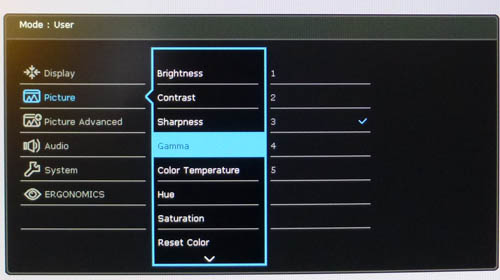
Gamma
|
Gamma Mode |
Average Gamma |
Deviance from
2.2 Gamma |
|
1 |
1.9 |
15% |
|
2 |
2.1 |
5% |
|
3 |
2.1 |
3% |
|
4 |
2.5 |
12% |
|
5 |
2.7 |
22% |
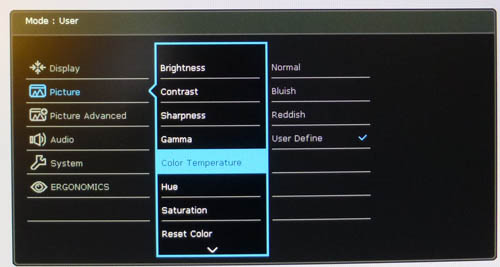
Colour Temperature
|
Color Temp
Mode |
Measured
White point (k) |
|
Normal |
5983 |
|
Bluish |
8586 |
|
Reddish |
5462 |
The default gamma mode of 3 delivered us an
average gamma closest to the 2.2 target, with only a minor 3% deviance. With
the color temperature setting, the bluish and reddish modes behaved as they
should, making the image cooler or warmer as expected. Unfortunately the
normal mode was not very close to our 6500k target, so you would have to enter
the user define mode and play around with the RGB channels to get a white
point closer to this target. The RGB settings listed in the following section
should help return a white point closer to 6500k.

Calibration
We used the
X-rite i1 Pro spectrophotometer combined with the LaCie Blue Eye Pro
software package to achieve these results and reports. An X-rite i1 Display Pro
colorimeter was used to validate the black depth and contrast
ratios due to lower end limitations of the i1 Pro device.
|
Monitor OSD Option |
Calibrated Settings |
|
Brightness |
18 |
|
Contrast |
50 |
|
Picture Mode |
User |
|
Gamma |
3 |
|
Color Temperature |
User Define |
|
RGB |
92, 92, 100 |

BenQ GW2765HT - Calibrated Settings
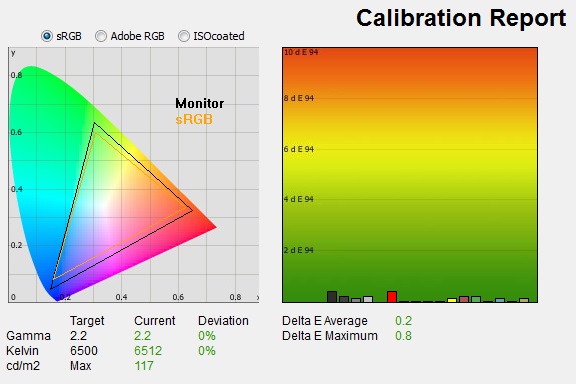
|
|
Calibrated Settings |
|
luminance (cd/m2) |
117 |
|
Black Point (cd/m2) |
0.12 |
|
Contrast Ratio |
944:1 |
We changed to the 'user' preset mode first
of all which would give us access
to the 'user define' color temperature mode, and therefore control over the RGB channels.
We also had access to make changes to the brightness and contrast settings which are
available in all the modes. All these OSD
changes allowed us to obtain an
optimum hardware starting point and setup before software level changes would be
made at the graphics card level. We left the LaCie software to calibrate
to "max" brightness which would just retain the luminance of whatever brightness
we'd set the screen to, and would not in any way try and alter the luminance at
the graphics card level, which can reduce contrast ratio. These adjustments
before profiling the screen would help preserve tonal values and limit
banding issues. After this we let the software carry out the LUT adjustments and create an
ICC profile.

Average gamma was now corrected to 2.2 average,
correcting the 3% deviance we'd seen out of the box. The
white point was also corrected to the target, now measured at 6512k, correcting
the fairly large 8% deviance out of the box. Luminance had been improved thanks
to the adjustment to the brightness control and was now being measured at 117
cd/m2. The next
step up for the brightness control bumped luminance up to 122 cd/m2,
so we left it here at a setting of 18. This
left us a black depth of 0.12 cd/m2 and maintained a good static contrast ratio
(for an IPS-type panel) of
944:1. This had dropped slightly once calibrated because of the adjustments to
the RGB channels. Colour accuracy of the resulting
profile was very good, with dE average of 0.2 and maximum of 0.8. LaCie would
consider colour fidelity to be very good overall.
Testing the screen with various colour gradients
showed mostly smooth transitions. There was some slight gradation in darker tones
but no banding introduced due to the adjustments to the
graphics card LUT from the profilation of the screen which was pleasing.
You can use our settings and
try our calibrated ICC profile if you wish, which are available in
our ICC profile database. Keep in mind that results will vary from one
screen to another and from one computer / graphics card to another.

Calibration
Performance Comparisons
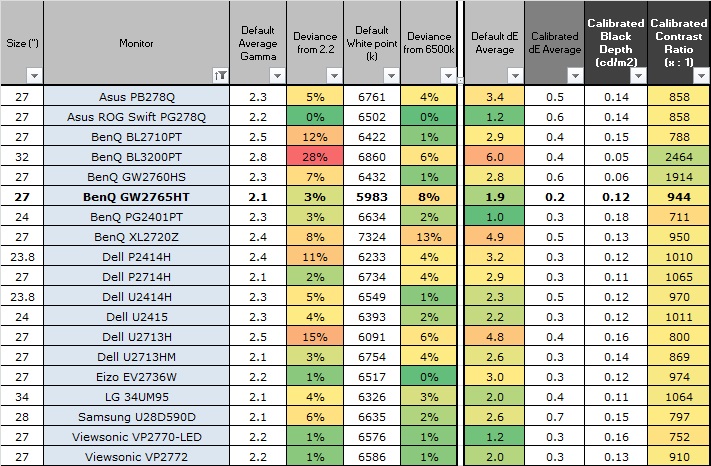
The comparisons made in this section try to give
you a better view of how each screen performs, particularly out of the box which
is what is going to matter to most consumers. When comparing the default factory
settings for each monitor it is important to take into account several
measurement areas - gamma, white point and colour accuracy. There's no point
having a low dE colour accuracy figure if the gamma curve is way off for
instance. A good factory calibration requires all 3 to be well set up. We have
deliberately not included luminance in this comparison since this is normally
far too high by default on every screen. However, that is very easily controlled
through the brightness setting (on most screens) and should not impact the other
areas being measured anyway. It is easy enough to obtain a suitable luminance
for your working conditions and individual preferences, but a reliable factory
setup in gamma, white point and colour accuracy is important and not as easy to
change accurately without a calibration tool.
From these comparisons we can also compare the
calibrated colour accuracy, black depth and contrast ratio. After a calibration
the gamma, white point and luminance should all be at their desired targets.
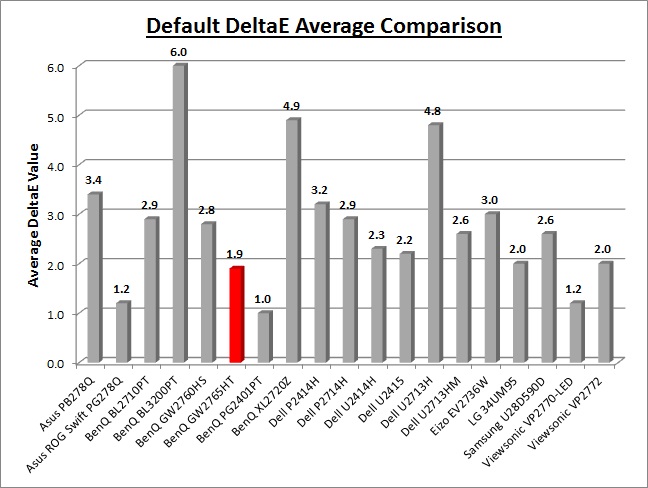
Default setup of the screen out of the box was
good with a gamma being very close to the target, contrast ratio being strong
(for an IPS-type panel) and dE colour accuracy being excellent. The only area
which was a little off was the colour temperature, being too warm by 8%
compared with the target.
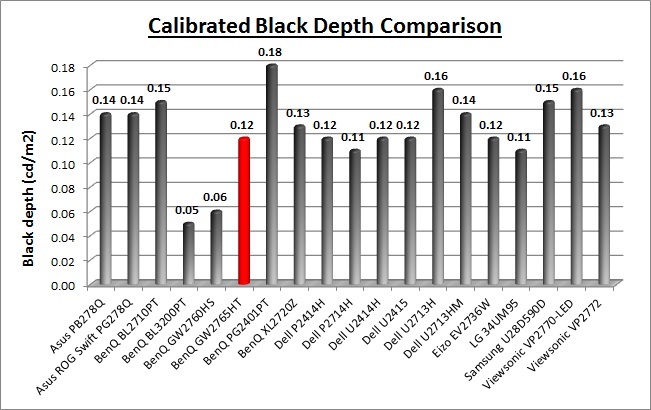

The display was strong when it came to black depth
and contrast ratio for an IPS-type panel. With a calibrated contrast ratio
of 944:1 we were pleased with the result for this technology. It can't compete with VA panel
types which can reach over 2000:1 easily, and commonly up to 3000:1.
|
Check Pricing and Buy - Direct Links
|
|
Amazon USA |
Amazon
UK | Amazon GER |
Amazon CAN
|
|
TFTCentral is a participant
in the Amazon Services LLC Associates Programme, an affiliate
advertising programme designed to provide a means for sites to earn
advertising fees by advertising and linking to Amazon.com, Amazon.co.uk,
Amazon.de, Amazon.ca and other Amazon stores worldwide. We also
participate in a similar scheme for Overclockers.co.uk. |

Viewing Angles
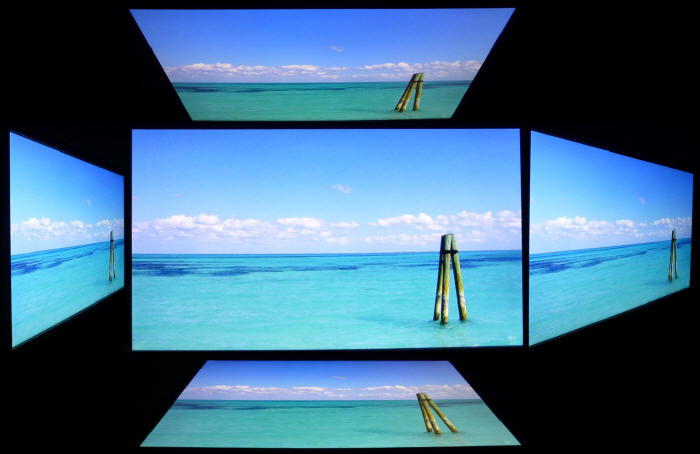
Above: Viewing
angles shown from front and side, and from above and below. Click for
larger image
Viewing angles of the GW2765HT were very good as you
would expect from an IPS-type panel (AHVA used here). Horizontally there was very little colour tone
shift until wide angles past about 45°. A slight darkening of the image occurred
horizontally from wider angles as you can see above as the contrast shifted
slighting. Contrast shifts were slightly more noticeable in the vertical field
but overall they were very good. The screen offered the wide viewing angles of
IPS-type technology and was free from the restrictive fields of view of TN Film
panels, especially in the vertical plane. It was also free of the off-centre
contrast shift you see from VA panels and a lot of the quite obvious gamma and
colour tone shift you see from some of the modern AMVA and PVA offerings. All as
expected really from a modern panel of this technology.

Above: View of an
all black screen from the side. Click for larger version
On a black image there is a characteristic white
glow when viewed from an angle, commonly referred to as IPS-glow. This is common
on most modern IPS-type panels and can be distracting to some users. If you view dark
content from a normal head-on viewing position, you can actually see this glow
as your eyes look towards the edges of the screen. This could be distracting if you work with a lot of dark
content perhaps.

Panel Uniformity
We wanted to test
here how uniform the brightness and colour temperature was across the screen, as well as identify any
leakage from the backlight in dark lighting conditions. Measurements of the luminance
and colour temperature were taken at 35 points across the panel on a pure
white background. The measurements for luminance were taken using BasICColor's calibration
software package, combined with an X-rite i1 Display Pro
colorimeter with a central point on the screen calibrated to 120 cd/m2. Measurements for colour temperature (white point) were taken using
BasICColor software and the i1 Pro spectrophotometer which can more accurately
measure the white point of different backlighting technologies. The below uniformity diagram shows the difference, as a percentage,
between the measurement recorded at each point on the screen, as compared with the
central reference point.
It is worth
noting that panel uniformity can vary from one screen to another, and can depend
on manufacturing lines, screen transport and other local factors. This is only a
guide of the uniformity of the sample screen we have for review.

Uniformity of Luminance
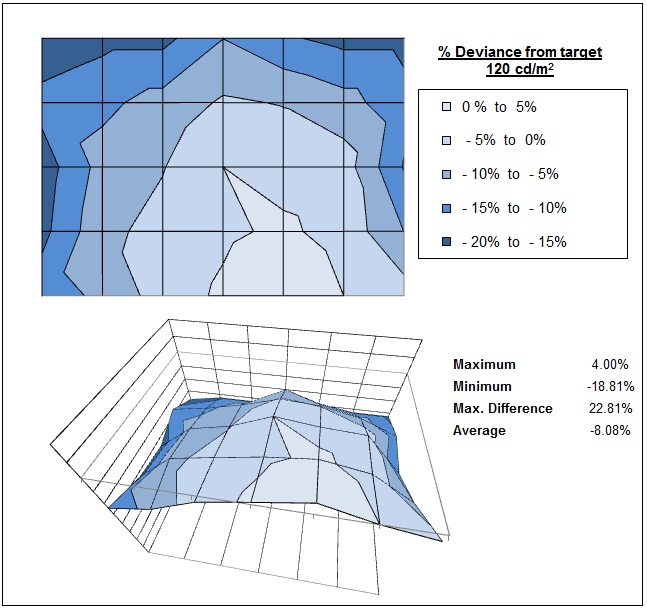
The luminance uniformity of the screen was
pretty good overall. The upper
corners of the screen were a little darker than the lower central region of
the panel, and luminance deviated by about 19% in the most extreme case,
down to 101 cd/m2. The luminance did seem to vary from top to
bottom in these tests, but it was hard to spot during normal use as the
deviance was not massive. Around 63% of the screen was within a 10% deviance
from the centrally calibrated point which was not too bad.

Backlight Leakage
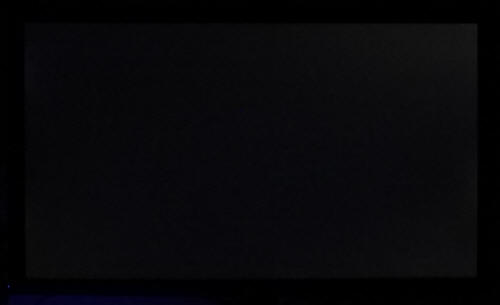
Above: All black screen in a darkened room. Click for larger version
As usual we also tested the screen with an all
black image and in a darkened room. A camera was used to capture the result. The
camera showed there was pretty much no backlight leakage here at all. A very
small amount was detected in the right hand corners but it was very slight. A
pleasing result..

General and Office Applications
The GW2765HT feature a large 2560 x 1440 WQHD
resolution which is only just a little bit less vertically than a 30" screen.
The pixel pitch of 0.233 mm is small as a result, and by comparison a standard
16:10 format 24" model has a pixel pitch of 0.270mm and a 30" model has 0.250mm.
Some users may find the small text a little too small to read comfortably, and
we'd advise caution if you are coming from a 19" or 22" screen for instance
where the pixel pitch and text are much larger. The extra screen size takes some
getting used to over a few days as there really is a lot of room to work with
but once you do, it's excellent. The massive resolution is really good for
office and general use, giving you a really big screen area to work with. It is
a noticeable upgrade from a 24" 1080p or 1200p resolution, and it's good to see
BenQ have opted to go with the high res panel here rather than their more common
1080p 27" models. For those wanting a high resolution for CAD, design, photo
work etc, this is a really good option. The image was very sharp and crisp and
text was very clear.
With its
WQHD display, you enjoy 77% more desktop space than a full HD screen to spread
out your windows and palettes.
The light AG, semi-glossy style coating of the
AHVA panel is
certainly welcome, and a very positive change from the older grainy and 'dirty'
appearance of older IPS AG coatings.
The wide
viewing angles provided by the AHVA panel technology on both horizontal and
vertical planes, helps minimize on-screen colour shift when viewed from
different angles.
The default setup of the screen was very good in
most regards, although the colour temperature let it down a little. We were also
pleased with the strong ~1000:1 contrast ratio provided here. Some simple
tweaking of the RGB levels as per our
calibration section should return you a
white point closer to 6500k, leaving you with a pretty reliable setup even
without a calibration tool.
The brightness
range of the screen was also very good, with the ability to offer a luminance
between 367 and 62 cd/m2. This should mean the screen is perfectly
useable in a wide variety of ambient light conditions, including darkened rooms.
A setting of ~17 in the OSD brightness control should return you a luminance
close to 120 cd/m2 out of the box. On another positive note, the brightness
regulation is controlled without the need for the use of the now infamous
Pulse-Width Modulation (PWM), and so those who suffer from eye fatigue or
headaches associated with flickering backlights need not worry.
There was no
audible noise or buzzing from the screen, even when specifically looking for it
using test images with a large amount of text at once. The screen also remains
cool even during prolonged use. There are no specific preset modes for reading,
but you can easily set up one of the other modes to your liking. The Low Blue
Light Mode is a useful feature when it comes to prolonged screen usage, helping
protect your eyes and make viewing more comfortable. We've already seen this in
action when we
tested the XL2720Z, and BenQ now provide this as a feature on all their new
screens. There are a decent range of input connections on this model, catering
for the demands of different graphics cards well. Useful to also have cables for
VGA, HDMI and DisplayPort included, although we're not sure why they didn't also
bundle a DVI?
The extra features are a little limited. There are
some basic 2x 1W speakers integrated into the screen, along with audio input and
output connections. They might be ok for the odd Youtube clip, office sounds or
an mp3, but aren't really up to much more. Sadly there are no USB ports provided on this model, which
is a bit of a shame as they've almost become standard on desktop displays now.
Other office-related features like ambient light sensors and human motion
sensors are not provided here. On the other hand there was a great range of
ergonomic adjustments available from the stand allowing you to obtain a
comfortable position for a wide variety of angles. The VESA mounting support may
also be useful to some people as well.
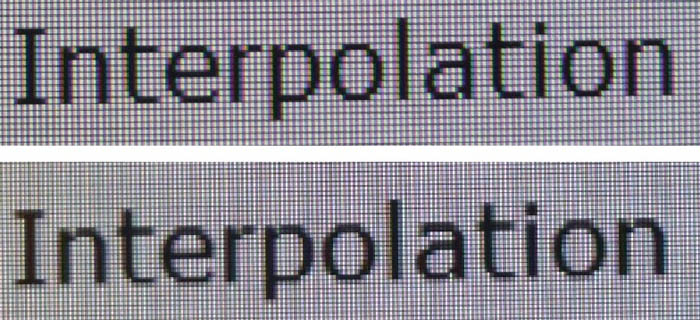
Above: photo of
text at 2560 x 1440 (top) and 1920 x 1080 (bottom)
The screen is designed to run at its native
resolution of 2560 x 1440 and at a 60Hz recommended refresh rate. However,
if you want you are able to run the screen outside of this resolution. We tested
the screen at a lower 1920 x 1080 resolution to see how the screen handles the
interpolation of the resolution, while maintaining the same aspect ratio of
16:9. At native resolution the text was very sharp and clear as we've already
discussed. When running at a 1920 x 1080 we were impressed actually with how
sharp the text appeared. There was very little overlap of pixels at all, and the
text looked good. The screen handles interpolation very well it seems.

Responsiveness and Gaming
|
Quoted G2G Response Time |
4ms G2G |
|
Quoted ISO Response Time |
12ms |
|
Panel Manufacturer and
Technology |
AU Optronics |
|
Panel Part |
M270DAN01.0 |
|
Overdrive Used |
Yes |
|
Overdrive Control Available to
User |
AMA |
|
Overdrive Settings |
Off, High, Premium |
The GW2765HT is rated by BenQ as having a 4ms G2G response time,
which indicates the panel uses
overdrive /
response time compensation (RTC) technology to boost pixel transitions
across grey to grey changes. There is user control over the overdrive impulse
within the OSD menu using the 'AMA' (Advanced Motion Accelerator) option. The
part
being used is the
AU Optronics M270DAN01.0 AHVA (Advanced Hyper Viewing Angles) panel. This is
an IPS equivalent technology, as opposed to their AMVA variety. Have a read about response time in
our
specs section if you need additional information about this measurement.
We will first test the screen using our thorough
response time testing method. This uses an oscilloscope and photosensor to
measure the pixel response times across a series of different transitions, in
the full range from 0 (black) to 255 (white). This will give us a realistic view
of how the monitor performs in real life, as opposed to being reliant only on a
manufacturers spec. We can work out the response times for changing between many
different shades, calculate the maximum, minimum and average grey
to grey (G2G) response times, and provide an evaluation of any overshoot present
on the monitor.
We use an
ETC M526
oscilloscope for these measurements along with a custom photosensor device.
Have a read of
our response time measurement article for a full explanation of the testing methodology and reported
data.
Response Time Setting Comparison (AMA Option)
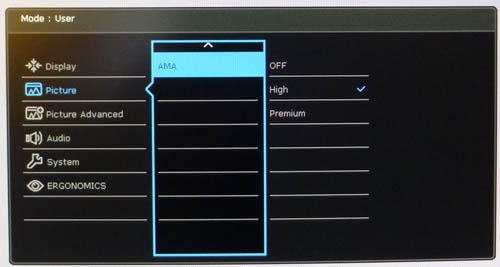
The GW2765HT comes with a user control for the
overdrive impulse available within the OSD menu in the 'picture' section as
shown above. There are three options under the AMA setting. First of all we carried out a smaller sample set
of measurements in all three of the AMA settings. These, along with various
motion tests allowed us to quickly identify which was the optimum overdrive setting
for this screen.

First we tested the screen with the AMA setting
off. Average response times were measured at 12ms G2G. Some transitions,
particularly those from black to darker shades were slower, reaching up to 18 -
21 ms. The pixel response times were pretty slow with AMA off, although with
overdrive not being applied there was no overshoot at all.

With AMA now on 'High', the middle setting,
response times had improved a fair amount. Average G2G response time was now
lower at 9.5ms. Some of the slower transitions had been improved as well,
although black > dark grey (e.g. 0 > 50) still seemed an issue. Some very minor overshoot was
creeping in to the readings but not at any level you'd see with the naked eye.
This mode definitely offered some improvement over AMA off without any draw
backs.

With AMA pushed up to the maximum 'premium'
setting, response times were once again improved. Average G2G was now 7.4, and
the slow transitions had all been sped up. None reached down as low as 4ms G2G
so the screen couldn't live up to its adventurous spec. Those transitions which had proved slow
before with AMA off now showed the most overshoot, a side effect of pushing the
overdrive impulse aggressively. The overshoot was high enough to be noticeable
in practice, and this mode is probably a bit too aggressive for our liking. The
'high' mode seemed to offer a better balance and is our preferred option. This
same panel was used in the
BenQ BL2710PT and on that screen the Premium AMA mode was ridiculously
aggressive, producing a response time of around 5.4ms G2G average, but with
overshoot ranging up to 130.6% in the worst case! Thankfully BenQ have been a
little more modest with the Premium AMA mode here.
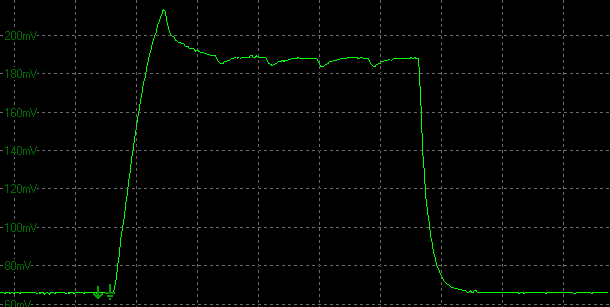
Transition: 0-50-0 (scale = 20ms)
As an example, the overshoot can be seen above for
the 0-50 transition, where it had a 20.5% overshoot.
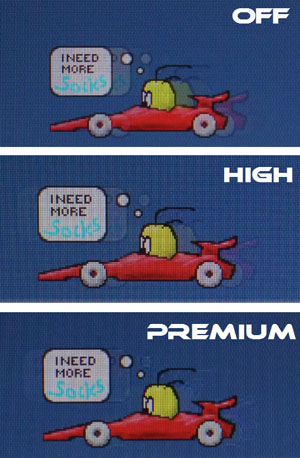
If we also carry out some subjective assessment of
the screen during gaming and with the use of the PixPerAn moving car tests, we
can also see the differences between each AMA mode easily enough with the naked
eye. With AMA Off there was a noticeable blur to the moving image as response
times were pretty slow. As you switch up to the 'High' setting the blur is
reduced nicely and the moving object becomes sharper. There is still some
blurring noticeable but no sign of any overshoot at all. When you switch up to
the 'Premium' AMA mode the blurring is reduced a little more, but you can pick
out some slight overshoot in the test images, where the trails are a bit
brighter than they should be. We know from our oscilloscope tests that there is
some pronounced overshoot on certain transitions, and not all of them are picked
out in these tests.
More Detailed Measurements - AMA High
Having established that the AMA 'High' mode seemed to
offer the best response/overshoot balance we carried
out our normal wider range of measurements as shown below:
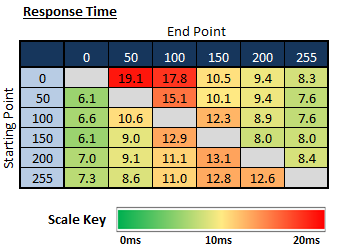
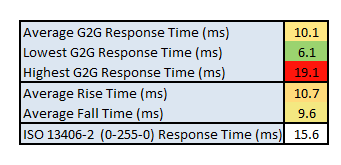
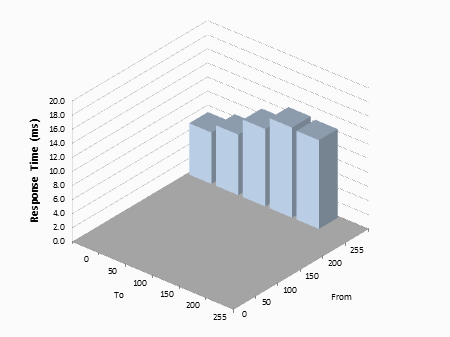
The average G2G response time was more accurately
measured at 10.1ms which was ok, but not great for an IPS-type panel overall. Some transitions
were faster at 6 - 7 ms minimum, particularly when changing to white (x >
255) or to black (x > 0). The rise and fall time average was very similar and so
pixel transition times were fairly consistent across the board, although a few
of the changes from black to darker grey shades were slower at 17 - 19ms and
dragged the average up a bit.
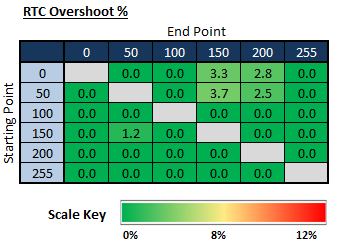
There was pretty much no overshoot as well in this
AMA mode, with only a couple of transitions showing anything at all, and
even then, very low and nothing you'd notice ever in practice.
The overdrive impulse was being applied well and in a controlled fashion which was pleasing.
If anything it was perhaps not quite aggressive enough as we would have probably
preferred a slightly faster pixel response time, and put up with some minor
overshoot in some cases.

Display Comparisons
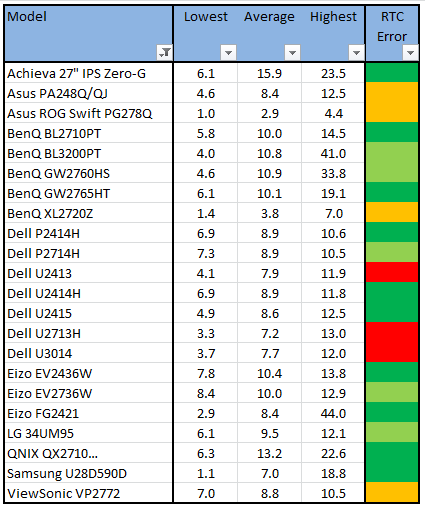
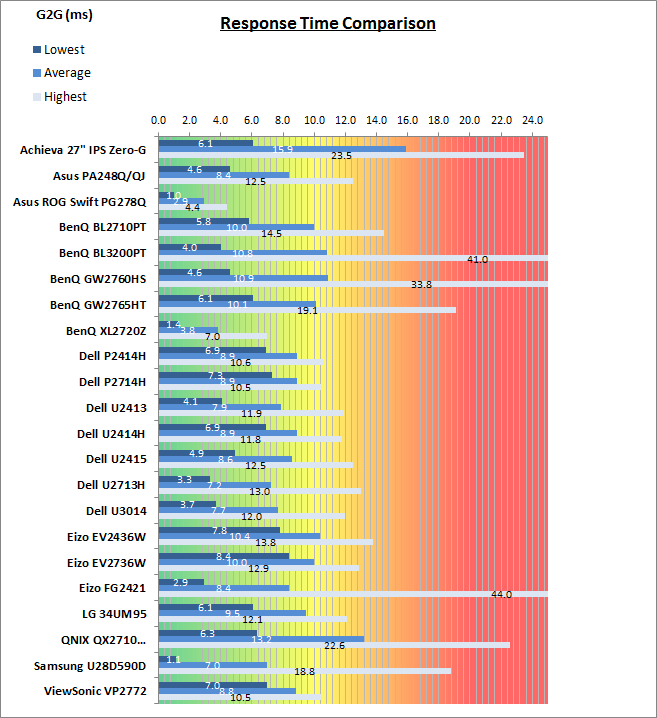
The above comparison table and graph shows you the
lowest, average and highest G2G response time measurement for a selection of screens we
have tested with our oscilloscope system. There is also a colour coded mark next
to each screen in the table to indicate the RTC overshoot error, as the response
time figure alone doesn't tell the whole story.
The response time performance of the GW2765HT using
the 'High' AMA setting was pretty good overall for an IPS-type panel, although
not great. With an
average G2G response time of 10.1ms measured, it was a little behind the fastest
IPS models (where a massive amount of overshoot was not introduced) like the Dell
U2415 (8.6ms) and U2414H (8.9ms). Those models are our reference point and
represent about as good as you can get from
modern IPS response times without introducing a significant amount of overshoot.
The GW2765HT was at least free from any noticeable overshoot, but we would have
perhaps even traded some low levels of RTC error for a slightly boosted response
time. The AMA 'Premium' setting pushed things a bit too far though, so somewhere
in the middle would have been useful. Some IPS-type models can reach lower response times, like the
Dell U2713H for instance (7.2ms)
but not without the cost of very high overshoot. Modern TN Film panels are still
much faster, reaching down to 2.9ms for instance in the example of the new
Asus
ROG Swift PG278Q (with moderate overshoot).
The screen was also tested using the chase test in
PixPerAn for the following display comparisons. As a reminder, a series of
pictures are taken on the highest shutter speed and compared, with the best case
example shown on the left, and worst case example on the right. This should only
be used as a rough guide to comparative responsiveness but is handy for a
comparison between different screens and technologies as well as a means to
compare those screens we tested before the introduction of our oscilloscope
method.

27"
4ms
G2G AU Optronics AHVA (AMA = High)
In practice the BenQ GW2765HT performed best with
AMA Response Time set to 'High'. There were pretty low levels of motion blur
and no ghosting visible. Thankfully no overshoot was detectable at all which was
pleasing.

27"
4ms
G2G AU Optronics AHVA (AMA = High)

27" 4ms G2G AU
Optronics AHVA (AMA Setting = High)

27" 12ms G2G
Samsung PLS (Response Time = Advanced)

27" 8ms G2G
LG.Display AH-IPS

27" 5ms G2G
Samsung PLS (Trace Free = 40)
We first of all compare the
GW2765HT against some other popular 27" general purpose displays. The GW2765HT
performed very similarly to the BL2710PT which is not surprising since it is
actually based on the exact same panel. Both were set to AMA 'High' as the
optimum response time level and produced very similar results. The ViewSonic
VP2770-LED was again very comparable in practice with similar low levels of
blurring. The Dell U2713HM was slightly faster and showed a slightly lower level
of blur to the moving image. Both the Dell and ViewSonic models were free from
overshoot as well like the BenQ's. Finally the Asus PB278Q was a little faster
than the GW2765HT with a little less blurring to the moving image, but some
overshoot was introduced here as a side-effect.

27"
4ms
G2G AU Optronics AHVA (AMA = High)

24"
8ms
G2G LG.Display AH-IPS (Response Time = Normal)

23.8" 8ms G2G
LG.Display AH-IPS

23.8" 8ms G2G
LG.Display AH-IPS
We can first of all compare the performance of the
GW2765HT against 3 fast (for IPS technology) 24" range screens from Dell. The
three Dell screens have an average measured response time of 8.6 - 8.9ms G2G so
were a little faster than the BenQ. They showed slightly lower blur in practice
but it was not a massive amount.

27"
4ms
G2G AU Optronics AHVA (AMA = High)

27"
1ms
G2G AU Optronics TN Film @ 144Hz (OD = Normal)

27" 1ms G2G
AU Optronics TN Film + 144Hz (AMA = High)

23.5" 4ms G2G
Sharp MVA + 120Hz
We've also included a comparison above against
3 very fast 120Hz+ compatible screens we have tested. The other screens shown
here are all aimed primarily at gamers and have various features and extras
which make them more suitable overall for gaming.
Firstly there is a comparison against the
Asus ROG Swift PG278Q with its 144Hz refresh
rate and fast response time TN Film panel. This showed very fast pixel response times and smooth movement thanks to
its increased refresh rate. You are able to reduce the motion blur even more
through the use of the ULMB strobed backlight as well if you need to. In other
related areas this screen also supports NVIDIA's G-sync technology. There was
some slight overshoot noticeable on the Asus but nothing major.
Then there is a comparison against the
BenQ XL2720Z with another very fast TN Film panel and 144Hz refresh rate.
This showed very low levels of motion blur, but some dark overshoot was
introduced as a side-effect as you can see. This screen even includes a native
Blur Reduction mode to help eliminate further perceived motion blur.
Lastly there is the MVA based Eizo FG2421 screen
with a fast response time (especially for the panel technology being used) and
120Hz refresh rate support. There is also an additional 'Turbo 240' motion blur
reduction mode which really helps reduce the perceived motion blur in practice.
While these pixel response tests from PixPerAn
give one view of the performance of the panel, there is something else going on as well here which can't be picked out by the camera. All of these other
gaming models are
running at 120Hz (or higher) refresh rates, which allows for improved 120fps+ frame rates and
in some cases the support of
3D stereoscopic content as well. This can really help improve smoothness and
the overall gaming experience so these screens still have the edge when it comes
to fast gaming. Any additional extras to reduce perceived motion blur can also
have a real benefit in practical terms, and again not easy to pick out with this
camera method.

The overall gaming performance of the BenQ
GW2765HT was reasonably good for an IPS-panel. The AMA 'High' setting seemed to
offer the optimum balance between response times and overshoot. With a 10.1ms
G2G average it was comparable to the BenQ BL2710PT we'd tested before with the
same panel. It couldn't quite keep up with the faster IPS models like the Dell
U2415 (8.6ms G2G) but was not really far behind. Thankfully it was free from any
overshoot problems at this setting which was very pleasing. It is a screen
lacking higher refresh rate support or any advanced gaming features like blur
reduction modes or G-sync, but as a general screen with decent IPS gaming
performance, it's decent enough.

Additional Gaming Features
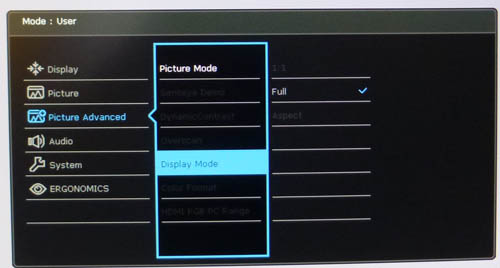
Aspect Ratio Control -
The GW2765HT has 3 options for
aspect ratio control through the OSD 'picture advanced' menu as shown above. There are options for
1:1 pixel mapping, full (fill the screen regardless of source aspect), or
'aspect' (fill as much of the screen as possible while keeping the correct
aspect). A good selection of options there which should meet user demands fine..
Preset Modes -
There is a specific 'game' available in the
OSD which appears to make the image a little cooler than our calibrated custom
mode. It gives you access to the dynamic contrast ratio control if you want to
use it as well.

Lag
We have written an in depth article about
input lag and the various measurement techniques which are used to evaluate
this aspect of a display. It's important to first of all understand the
different methods available and also what this lag means to you as an end-user.
Input Lag vs. Display Lag vs. Signal
Processing
To avoid confusion with different terminology we
will refer to this section of our reviews as just "lag" from now on, as there
are a few different aspects to consider, and different interpretations of the
term "input lag". We will consider the following points here as much as
possible. The overall "display lag" is the first, that being the delay between
the image being shown on the TFT display and that being shown on a CRT. This is
what many people will know as input lag and originally was the measure made to
explain why the image is a little behind when using a CRT. The older stopwatch
based methods were the common way to measure this in the past, but through
advanced studies have been shown to be quite inaccurate. As a result, more
advanced tools like SMTT provide a method to measure that delay between a TFT
and CRT while removing the inaccuracies of older stopwatch methods.
In reality that lag / delay is caused by a
combination of two things - the signal processing delay caused by the TFT
electronics / scaler, and the response time of the pixels themselves. Most
"input lag" measurements over the years have always been based on the overall
display lag (signal processing + response time) and indeed the SMTT tool is
based on this visual difference between a CRT and TFT and so measures the
overall display lag. In practice the signal processing is the element which
gives the feel of lag to the user, and the response time of course can
impact blurring, and overall image quality in moving scenes. As people become
more aware of lag as a possible issue, we are of course keen to try and
understand the split between the two as much as possible to give a complete
picture.
The signal processing element within that is quite
hard to identify without extremely high end equipment and very complicated
methods. In fact the studies by Thomas Thiemann which really kicked this whole
thing off were based on equipment worth >100,1000 Euro, requiring extremely high
bandwidths and very complicated methods to trigger the correct behaviour and
accurately measure the signal processing on its own. Other techniques which are
being used since are not conducted by Thomas (he is a freelance writer) or based
on this equipment or technique, and may also be subject to other errors or
inaccuracies based on our conversations with him since. It's very hard as a
result to produce a technique which will measure just the signal processing on
its own unfortunately. Many measurement techniques are also not explained and so
it is important to try and get a picture from various sources if possible to
make an informed judgement about a display overall.
For our tests we will continue to use the SMTT
tool to measure the overall "display lag". From there we can use our
oscilloscope system to measure the response time across a wide range of grey to
grey (G2G) transitions as recorded in our
response time
tests. Since SMTT will not include the full response time within its
measurements, after speaking with Thomas further about the situation we will
subtract half of the average G2G response time from the total display lag. This should allow us to give a good estimation of
how much of the overall lag is attributable to the signal processing element on
its own.
Lag Classification
To help in this section we will also introduce a broader classification system
for these results to help categorise each screen as one of the following levels:
-
Class 1)
Less than 16ms / 1 frame lag - should be fine for gamers, even at high levels
-
Class
2)
A lag of 16 -
32ms / One to two frames - moderate lag but should be fine for many gamers.
Caution advised for serious gaming and FPS
-
Class
3)
A lag of more
than 32ms / more than 2 frames - Some noticeable lag in daily usage, not
suitable for high end gaming
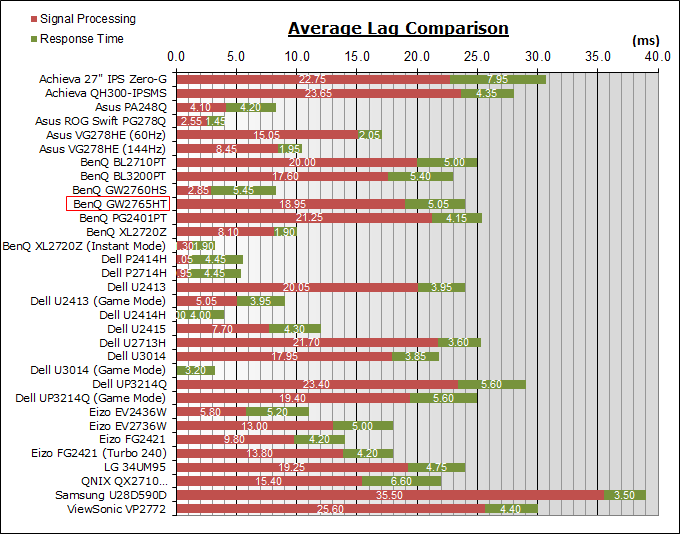
For the full reviews of the models compared here and the dates they were written
(and when screens were approximately released to the market), please see our
full
reviews index.
|
(Measurements in ms) |
|
|
Total Display Lag (SMTT
2) |
24.0 |
|
Pixel Response Time
Element |
5.05 |
|
Estimated Signal
Processing Lag |
18.95 |
|
Lag Classification |
2 |
|

Class 2 |
We have provided a comparison above against other
models we have tested to give an indication between screens. The screens
tested are split into two measurements which are
based on our overall display lag tests (using SMTT) and half the average G2G
response time, as measured by the oscilloscope. The response time is split from
the overall display lag and shown on the graph as the green bar. From there, the
signal processing (red bar) can be provided as a good estimation.
The screen showed a total average display lag of
24.0 ms as measured with SMTT 2. Taking into account half the average G2G
response time at 5.05ms ('High' AMA Response Time setting), we can estimate that
there is ~18.95 ms of signal processing lag on this screen. This is modest and
equates to just over 1 frame of processing lag, which could be problematic for
fast or competitive gaming.

Movies and Video

The following summarises the screens performance
in video applications:
-
27"
screen size makes it a reasonable option for an all-in-one multimedia screen,
but being quite a bit smaller than most modern LCD TV's nowadays.
-
16:9
aspect ratio is more well suited to videos than a 16:10 format screen, leaving
smaller borders on DVD's and wide screen content at the top and bottom.
-
2560 x
1440 resolution can support full 1080 HD resolution content.
-
Digital interfaces support HDCP for any encrypted and protected content
-
HDMI and DisplayPort
connections available. Nice to see HDMI connectivity included for modern DVD
players, Blu-ray, consoles etc.
-
Cables provided in the box
for DisplayPort and HDMI cable which is nice.
-
Light,
semi-glossy style
AG coating provides clear images with no major graininess, and without the
unwanted reflections of a glossy solution.
-
Wide
brightness range adjustment possible from the display, including high maximum
luminance of ~367
cd/m2 and a good minimum luminance of
62 cd/m2. This should afford you very good control for different
lighting conditions. Contrast ratio remains stable across most of that adjustment
range as well and is very good for an IPS-type panel. Brightness regulation is controlled
without the need for PWM and so is flicker free at all settings which is
pleasing.
-
Black
depth and contrast ratio are very good for an IPS-type panel at 944:1 after
calibration. Detail in darker scenes should not be lost as a result.
-
There
is a specific 'movie' preset mode available for movies or video in the OSD
which looked fairly similar to our calibrated custom mode. Useful if you want
to set up another preset for movie viewing where maybe you want brightness
boosted somewhat compared with every day desktop use.
-
Good
pixel responsiveness which can handle fast moving scenes in movies without
issue. No overshoot issues when sticking to the 'high' AMA mode
which is great news.
-
Wide viewing angles from IPS-type (AHVA) panel technology
meaning several people could view the screen at once comfortable and from a
whole host of different angles. White glow from an angle on black content may
be problematic to some users.
-
No
noticeable backlight leakage which is good, even in darkened room conditions.
-
Wide range of ergonomic adjustments available
from the stand, allowing you to adjust the screen to suit varying viewing
positions. The side to side swivel is too stiff and basically just involves
you moving the whole screen, which might be a bit of a pain for viewing movies
from a non desk position.
-
Basic
2x 1W integrated stereo speakers offered on this model, but not up to much for
movie viewing, only the occasional Youtube clip or mp3. There is also an audio
out connection if you want to connect to headphones or separate speakers when
sending sound to the screen over HDMI.
-
Hardware aspect ratio control options are good, including options to maintain
the source aspect and also for 1:1 pixel mapping.
-
Picture By Picture (PbP) or Picture In Picture (PiP) are not available on
this model.

Conclusion
The BenQ GW2765HT performed pretty well overall,
meeting our expectations really for this kind of display. Connectivity and
features were solid, with a good range of video inputs and a decent stand
provided. A few basic additional extras like simple speakers and an audio input
added a little, but the screen was a little lacking in some common extras like
USB ports for instance. The all-round performance was decent from the AHVA
panel. Default setup was on the whole pretty good, if only they had just offered
a slightly better colour temperature out of the box. The contrast ratio was
impressive though and represented a good figure for an AHVA panel. Image
stability and viewing angles were as expected from an IPS-type panel and we were
pleased that BenQ continue to invest in flicker free backlighting and their
useful Low Blue Light mode.
The GW2765HT uses the same AHVA panel as BenQ's
BL2710PT model it should be noted. As a result, many areas of the screens
performance are quite comparable. For instance the response times were basically
the same when you had selected the optimum AMA setting. Lag was also the same
between the two since the same scaler and electronics are presumably being used
also. They were both a little too slow for serious, competitive gaming but
offered reasonable performance for more regular users. Overall viewing angles,
colour stability, IPS-glow etc were also the same between the two models. The
GW2765HT has a better out of the box setup, as we'd found the BL2710PT to have a
skewed gamma (2.5) at default settings. This was easy enough to correct on the
BL of course with a simple setting change and once fixed, that model actually
performed a little better before calibration because of its more reliable white
point. The contrast ratio was much better on the GW model though, achieving
944:1 after calibration whereas the BL had only managed 788:1, so this was an
area we were pleased to see had been improved.
While it offers similar performance
characteristics from a panel point of view it has some different features. The
BL model offers additional USB ports (v2 and 3), slightly better speakers (2x
3W), a human motion sensor, ambient light sensor and touch sensitive buttons.
This carries a price premium of course of around £60 GBP. If you need some of
these additional features then the BL series is available, but the GW model
offers a more cost-effective option for the more general, basic user.
If you appreciate the review
and enjoy reading and like our work, we would welcome a
donation
to the site to help us continue to make quality and detailed reviews for you.
|
Pros |
Cons |
|
Good default setup, but white
point needs correcting a little. Strong contrast ratio |
Missing a few extras like USB
ports for instance |
|
Good connectivity options and
a decent stand |
Default colour temperature
could have been a little better |
|
Flicker free backlight, no PWM |
Lag is a little too high for
serious gaming |
|
Check Pricing and Buy - Direct Links
|
|
Amazon USA |
Amazon
UK | Amazon GER |
Amazon CAN
|
|
TFTCentral is a participant
in the Amazon Services LLC Associates Programme, an affiliate
advertising programme designed to provide a means for sites to earn
advertising fees by advertising and linking to Amazon.com, Amazon.co.uk,
Amazon.de, Amazon.ca and other Amazon stores worldwide. We also
participate in a similar scheme for Overclockers.co.uk. |